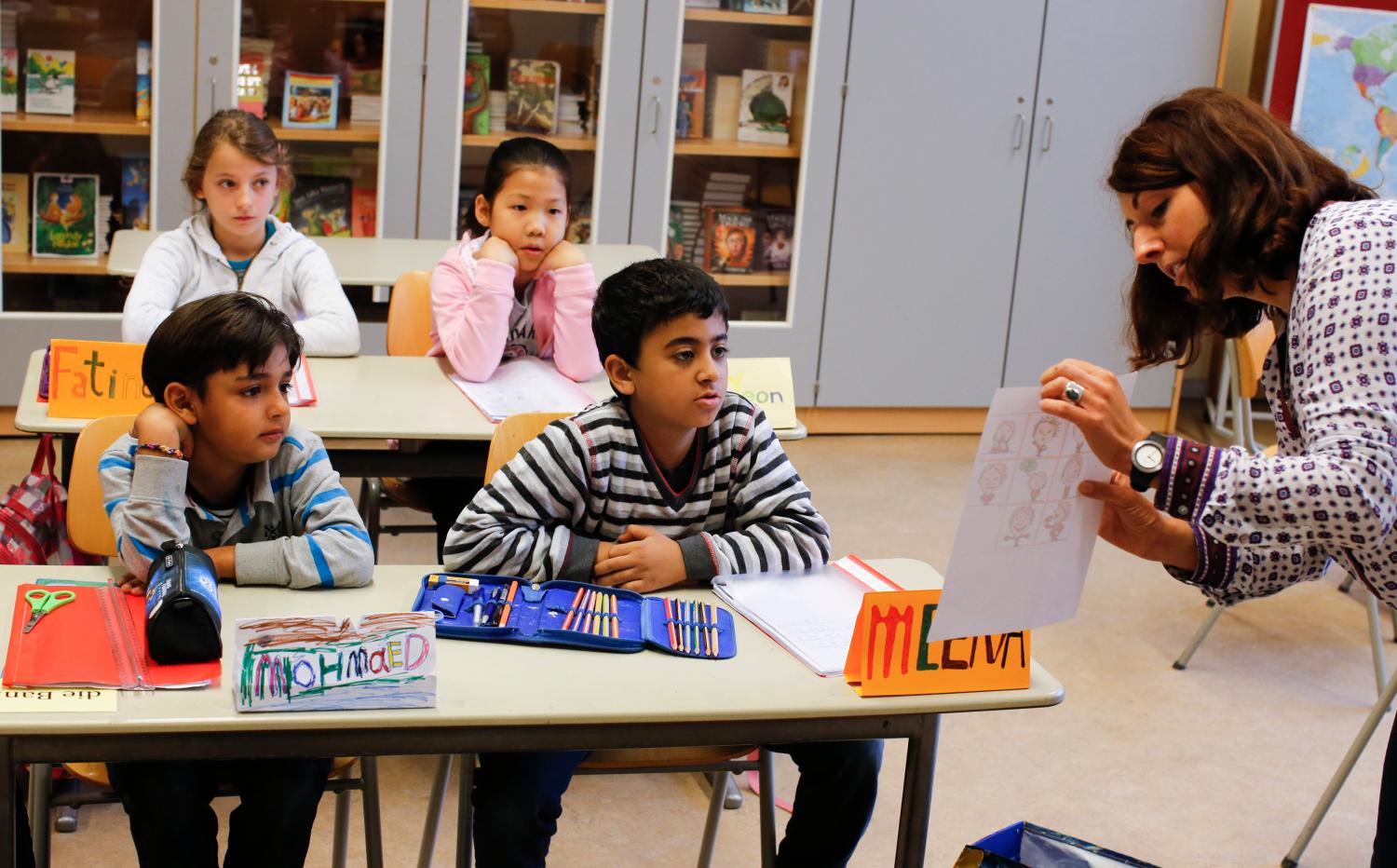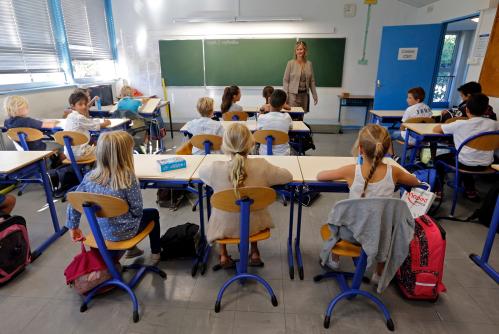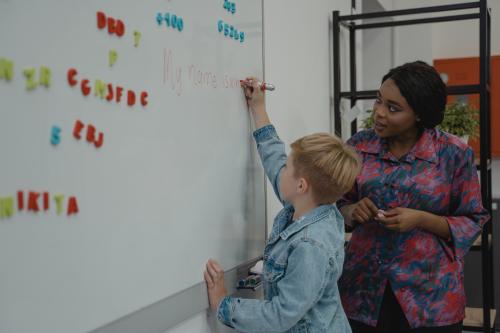Since President Trump took office nearly a year ago, it seems that most of the education news has moved decidedly away from one of the key pillars of the Obama-era education platform: teacher quality. Increasing overall teacher quality, and particularly disadvantaged students’ access to effective teachers, were principles that surfaced time and again from the U.S. Department of Education under the leadership of secretaries Arne Duncan and John King. Though this priority has been set aside at the federal level in favor of school choice initiatives and deregulation, many practitioners in state and district offices have continued to quietly tinker with various reforms to teacher policies and staffing practices.
Making strategic use of highly effective teachers
One such under-the-radar effort attempting to work on teacher quality at the local level is the Opportunity Culture initiative. Currently, more than 150 schools across eight states are implementing Opportunity Culture models, according to Public Impact, the education organization that began development of the initiative in 2009.
The theory of action behind the Opportunity Culture initiative is best summed up by its tagline: Extending the reach of excellent teachers. When it partners with districts and schools, the program offers different models that attempt to make highly effective teachers more influential on student learning. It accomplishes this by directly increasing strong teachers’ student loads (for example, through larger class sizes or rotating multiple classes through various learning stations), or indirectly reaching more students by becoming instructional coaches to teams of teachers (typically in the same grade or subject area).
Being selected for one of these roles is intended to be a reward for excellent teaching. (Application to the program is voluntary for teachers.) Salary supplements paid to teachers in these more influential roles can be large—averaging about $12,000 in the most recent year—and are paid out through the school year, not simply as a one-time bonus. Such rewards are believed to provide an incentive for other teachers to prove their excellence and make a larger impact without having to leave the classroom; hence, the name Opportunity Culture.
New evaluation of pilot schools
Based on our newly released evaluation of many of the earliest implementing Opportunity Culture schools, we found evidence that redefined roles for highly effective teachers—in particular, the coaching-focused Multi-classroom Leader model—yielded statistically significant learning improvements for students in math.
We acquired data from the three largest school districts implementing these models (based in Charlotte-Mecklenburg and Cabarrus County Schools, N.C., and Syracuse, N.Y.) to conduct our evaluation of the program. Collectively, these districts include 44 of the early adopter sites, and schools have been implementing the program for two to three years.
Overall, we found statistically significant improvements in student learning associated with implementation of the Opportunity Culture program in both subjects we analyzed for the study. Our analysis, however, revealed that many classrooms in these schools—even those not directly involved with the program—made significant improvements in their performance, which causes a bit of a wrinkle in interpreting the overall results. These gains in other classrooms may be due to excitement the program generated among other teachers, motivating others to work harder to demonstrate their effectiveness for consideration in subsequent years—a spillover effect of the program. Alternatively, these gains may potentially be due to other ongoing turnaround efforts in many of the pilot schools unrelated to the program. (Though the Opportunity Culture initiative is not specifically designed to be a school turnaround strategy, one of the study districts prominently used it as one).
Because we were unable to credibly separate any potential spillover effects versus those that were a product of other school improvement efforts, we are most confident in our results from a more conservative estimation strategy that explicitly removes impacts from other classrooms in the pilot schools. These results were statistically significant and large in math for students in Opportunity Culture classrooms, equivalent in magnitude to the gains associated with replacing an average teacher with one in the top quartile of teacher value-added performance. In reading, though, the more conservative estimates showed no difference in classrooms due to the Opportunity Culture models.
Most of the gains we observed were driven by the initiative’s Multi-classroom Leader model, which showed teachers paired with an excellent teacher-turned-coach significantly improved their classroom performance (based on both value-added estimates and observational ratings). The few classes that the excellent teacher taught also continued to show high marks.
On the other hand, Opportunity Culture models that increased the student load of effective teachers (by using blended learning or other learning rotations) were associated with either null or negative results on student learning in both reading and math, contrary to the program’s expectations. It is worth noting that these models were also less common in pilot schools, compared to the Multi-classroom Leader model.
Bigger impacts from the best teachers
What these results tell us is that schools can produce a more effective workforce without necessarily having to go through the controversial and unpopular step of removing the least effective teachers from the classroom. To this point, these “deselection” strategies appeared to be the primary method of enhancing teacher quality in the workforce, given underwhelming evidence of teacher professional development (as typically implemented in districts) making a difference.
By contrast, the Opportunity Culture approach argues that we could do more with the same teachers by simply being strategic about how we are utilizing our strongest teachers. This change in staffing strategy is analogous to the “Moneyball”-inspired changes to basketball offensive strategies in recent years that have resulted in NBA games with more three pointers than ever before as teams lean more heavily on previously underutilized talent.
These results also draw our attention to the importance of frequent and personalized coaching as a way to truly develop talent in the teaching workforce (as opposed to standard professional development exercises). Though the value of instructional coaches are generally acknowledged in the field, practical challenges often stand in the way of helping them really make an impact on instruction. Opportunity Culture’s approach to instructional leadership is a variant on the proven formula for better coaching and mentoring to improve teachers’ classroom practice. The twists with the Opportunity Culture program are, first, providing even more personalized attention (typically one coach per six team teachers, compared to standard practice of one coach per school), and second, ensuring that only the best teachers are being elevated (and thus rewarded) as coaches.
Furthermore, these results argue that the recent change in policy focus away from teacher quality was perhaps a little premature. This evaluation and other evidence shows that strategic policies with teachers can make a measurable impact on student learning.
The Brookings Institution is committed to quality, independence, and impact.
We are supported by a diverse array of funders. In line with our values and policies, each Brookings publication represents the sole views of its author(s).









